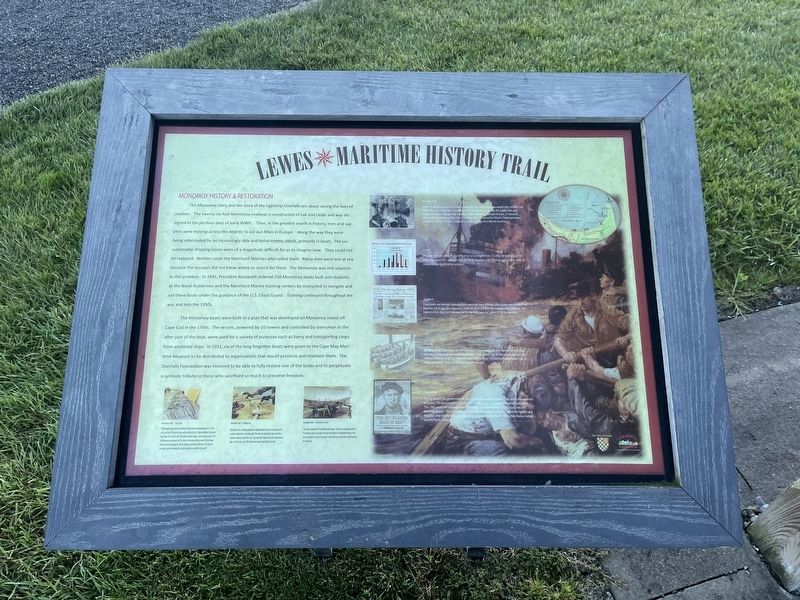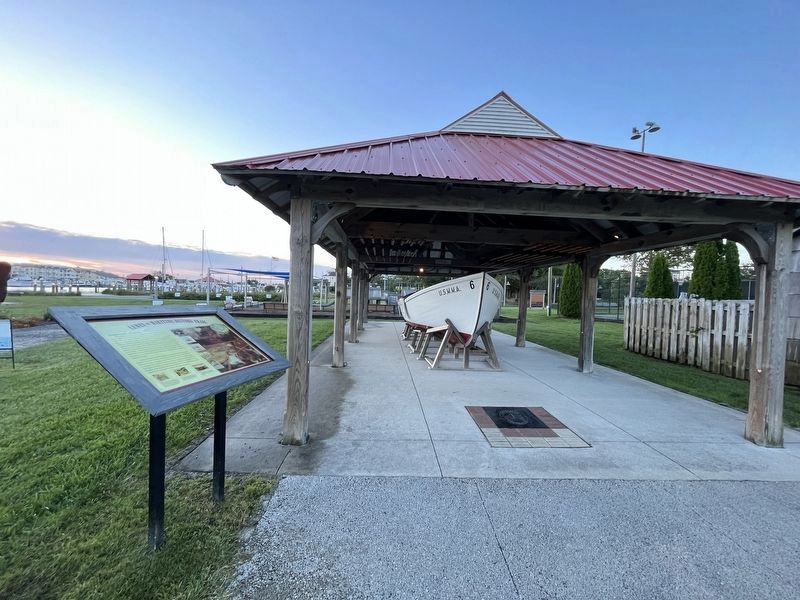Lewes Historic District in Sussex County, Delaware — The American Northeast (Mid-Atlantic)
Monomoy History & Restoration
Lewes Maritime History Trail

Photographed By Devry Becker Jones (CC0), September 15, 2023
1. Monomoy History & Restoration Marker
The Monomoy story and the story of the Lightship Overfalls are about saving the lives of seamen. The twenty-six foot Monomoy rowboat is constructed of oak and cedar and was designed in the perilous days of early WWII. Then, in the greatest sealift in history, men and supplies were moving across the Atlantic to aid our Allies in Europe. Along the way they were being intercepted by an increasingly able and lethal enemy attack, primarily U-boats. The unsustainable shipping losses were of a magnitude difficult for us to imagine now. They could not be replaced. Neither could the Merchant Marines who sailed them. Many men were lost at sea because the rescuers did not know where to search for them. The Monomoy was one solution to this problem. In 1942, President Roosevelt ordered 250 Monomoy boats built and students at the Naval Academies and the Merchant Marine training centers be instructed to navigate and sail these boats under the guidance of the U.S. Coast Guard. Training continued throughout the war and into the 1950s.
The Monomoy boats were built to a plan that was developed on Monomoy Island off Cape Cod in the 1740s. The vessels, powered by 10 rowers and controlled by steersmen in the after part of the boat, were used for a variety of purposes such as livery and transporting cargo from anchored ships. In 2011, six of the long forgotten boats were given to the Cape May Maritime Museum to be distributed to organizations that would preserve and maintain them. The Overfalls Foundation was honored to be able to fully restore one of the boats and to perpetuate a symbolic tribute to those who sacrificed so much to preserve freedom.
[Captions:]
Restoration Slide 1 - bone yard
This Monomoy began service in the Basic Training Center at Sheepshead Bay, N.Y. in 1942 and served until 1954 and was then used in training at the U.S. Merchant Marine Academy at Kings Point, N.Y. until the early 1990s when it became surplus. Upon arrival in Lewes in 2011, the Monomoy was surveyed and the process of removing decking, rails and frames began. There was extensive damage to the ribs, planking and framing of the boat. The removed parts were stored in somewhat their original position we called the "bone yard."
Restoration Side 2 - bending ribs.
Working from the amidships outward, the original broken frames were removed and the curvature duplicated on a bending table. The white oak replacement pieces were then steamed and bent to match the curve. they were then shaped, fitted and screwed back in place. In the process, over 1,300 screws were removed and replaced by hand.
Restoration Slide 3 - Monomoy on a Stand
The tedious replacement
Burning ships
United States resources committed to supplying the Allies greatly escalated after its entry in WWII. However, resources committed by the Axis powers to disrupt the supply lines also sharply increased. Transport by individual ships evolved to convoys of ships. In the early years of the war, burning ships in the Delaware Bay and along the Atlantic Coast were commonplace. Debris and bodies littered our Delaware and other Atlantic beaches.
Chart
Shipping was lost in magnitudes difficult for us to imagine now. In 1942, for example, 1,700 allied ships were lost — some 33 ships per week; however, only 750 ships were built in 1942, an imbalance that could not be sustained.
Survivors
Crews were also lost and replacing them was even more difficult. After a ship was attacked and the crew was at sea, they frequently could not be found and they subsequently perished. The fraction of U.S. Merchant Marines lost during WWII was the highest of all the services.
Training
By 1942, the U.S. Merchant Marine Training Centers were open and mariners were being trained in sea survival techniques by the U.S. Coast Guard. The 26' Monomoy became the standard lifeboat on all U.S. merchant and military ships. It could be rowed by ten men or sailed and would hold over twenty rescued mariners.
Recruiting
During the War, the government recognized that full public support to the effort was essential to victory. The government hired artists to create posters designed to promote patriotism. This 1942 poster encouraged a specific mission: to attract former seamen back into the Merchant Marine. Over 220,000, ages 16 to 60, answered the call and crewed the tankers and freighters that maintained a nonstop supply line to England, North Africa, Italy, Russia, Europe and the Pacific Theaters.
Erected by City of Lewes. (Marker Number 11.)
Topics and series. This historical marker is listed in these topic lists: War, World II • Waterways & Vessels. In addition, it is included in the Lost at Sea series list. A significant historical year for this entry is 1942.
Location. 38° 46.661′ N, 75° 8.482′ W. Marker is in Lewes, Delaware, in Sussex County. It is in the Lewes Historic District. Marker is on Shipcarpenter Street north of Pilottown Road, on the right when traveling north. Touch for map. Marker is at or near this postal address: 2 Shipcarpenter St, Lewes DE 19958, United States of America. Touch for directions.
Other nearby markers. At least 8 other markers are within walking distance of this marker. Lightship Overfalls (a few steps from this marker); Lightship LV-118 Overfalls (within shouting distance of this marker); The Lightship Overfalls LV-118/WAL-539 (within shouting distance of this marker); Overfalls Lightship (within shouting distance of this marker); Life Saving Station (within shouting distance of this marker); The Blizzard of 1888 (within shouting distance of this marker); Menhaden Fishing Industry (within shouting distance of this marker); Shipbuilding (about 400 feet away, measured in a direct line). Touch for a list and map of all markers in Lewes.
Credits. This page was last revised on March 8, 2024. It was originally submitted on September 15, 2023, by Devry Becker Jones of Washington, District of Columbia. This page has been viewed 107 times since then and 44 times this year. Photos: 1, 2. submitted on September 15, 2023, by Devry Becker Jones of Washington, District of Columbia.
